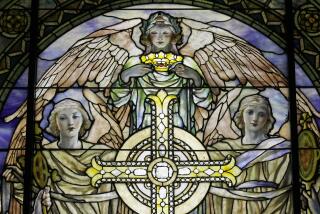A Daredevil Pilot and Angel Falls
- Share via
Jimmie Angel -- no angel despite his name -- was a daredevil pilot and a “hell-raising soldier of fortune” obsessed with finding gold. Instead, he found the world’s tallest waterfall, 3,200-foot Angel Falls in Venezuela.
The pioneering aviator could land on a dime but had a rather rough reputation. “He was misnamed,” Glendale pilot and author John Underwood said in a recent interview. “He was a scoundrel.”
Angel told the world that he flew in World War I, and perhaps he did -- but there’s no documentation from either Canada or the United States. He said he flew bombers over China and Russia in the 1930s, but again, there is nothing to back up his claims.
Angel “owned his own airplane factory in Los Angeles and made a lot of money,” his son, Rolan Angel of Santa Barbara, said in a recent interview. “But when the Depression hit, he lost it all. Never saved a dime after that.”
Rolan Angel said his father flew with some of the best, including Howard Hughes; he has a photo of the pair together. His dad told him that he’d taught World War I flying ace Eddie Rickenbacker to fly, but there’s no proof.
And although the waterfall was named for Angel, he didn’t really discover it. Native peoples had known of it for generations, and explorer Ernesto Sanchez La Cruz “discovered” it in 1910. Headline writers apparently had a hand in naming it for Angel.
James Crawford Angel was born in Missouri in 1899 and began flying at 15. By the 1920s, he was married to a woman named Virginia and barnstorming across the country with his own flying circus. He also smuggled Chinese immigrants into the United States from Mexico, Underwood said.
“Angel was a hell-raising soldier of fortune whose calling card proclaimed the bearer to be available any time to fly anything anywhere,” said Underwood, 73, who wrote about aviation’s early days in “Madcaps, Millionaires and ‘Mose.’ ” His next book, about Glendale’s Grand Central Terminal, is due out in August.
Navy and TWA flier Tommy Tomlinson first met Angel at a San Diego airfield, he wrote in his 1930 book, “The Sky’s the Limit.” Looking over Angel’s plane, a “hybrid junk pile,” Tomlinson noticed that the “passenger compartment was carefully boxed in with light plywood, and that there was not a sign of a belt or grip to which passengers might hold.”
When he asked Angel about the design, “his reply shook my faith in humanity.”
Tomlinson wrote: “ ‘Well, Tommy,’ he said, ‘I built it that way so that in case I got [Chinese] aboard and the revenue [agents] chased me, I can slip offshore 15 or 20 miles and dump ‘em out. Get me?’ ”
Angel had grand plans, many of which barely got off the ground, The Times reported.
In 1928, he took off from Fresno for South America’s Cape Horn, but mechanical problems landed him and his crew in Guaymas, Mexico. Angel became ill, went broke and had to ship the plane back to Los Angeles by boat.
In December 1930, Angel and five other pilots took off from Glendale Grand Central Air Terminal in a tri-motor Albatross for an endurance flight. They had to give up after just 25 minutes because the plane was tail-heavy. The extra 95 pounds belonged to a stowaway, parachute jumper Billie Brown.
The Albatross later became part of a gas station -- on Ventura Boulevard according to Underwood, though Rolan Angel thinks it was Wilshire Boulevard. Planes sheltered gas pumps at both locations, but only one was Jimmie Angel’s. Both are gone now.
Also in 1930, Angel applied for federal permission to fly from San Francisco to Glendale with his hands and arms manacled to the cockpit seat. He planned to use his legs and knees to manage the controls, The Times reported. Permission denied.
In the early 1930s, Underwood said, Angel secretly trained a group of Chinese to fly at the behest of the Chinese government. In 1931, after a year of training at Dycer Airfield on Western Avenue, the cadets in the so-called Chinese Flying Club returned home, where they reportedly became instructors in the Chinese air force.
Then came a period in Angel’s life that has been told repeatedly in magazines and newspapers, including The Times.
In 1933, Angel was plying his trade as a bush pilot in South America, ferrying men and supplies out of the jungles. There, he said, an old prospector hired him to find a mythical “golden river.”
With the prospector’s payment, which Angel variously reported as $3,000 or $5,000, the miner guided him to a mysterious mountain site in Venezuela known as Auyan Tepui, or Devil’s Mountain, Angel said. It was here that he first saw the dramatic waterfall spilling from the mountaintop.
After three days of panning, the pair had 75 pounds of gold nuggets -- the maximum their plane could carry. Soon after reaching civilization, the miner died; what happened is unclear.
Angel headed back to the States to raise money to continue his adventure.
He told all who would listen about a river of gold and the old prospector who had led him to it. All he had to do, Angel said, was find it again.
In 1935, he was broke, divorced and down on his luck when he found two backers to finance an expedition to the mountain. But they returned to the States empty-handed.
In 1937, he was back in Venezuela with his new bride, red-haired Mavis Marie, and two other passengers. As they headed for the mountain, Angel mistook the shimmer of the falls for the glint of gold and landed his borrowed Flamingo plane in 6 feet of mud atop Devil’s Mountain. There it stayed, mired in the muck.
Survival became more important than gold. It took the four two weeks to hack through the jungle and down the mountain to safety.
In 1938, a mining engineer reported on the remote area that Angel had visited, and the American Museum of Natural History sent an expedition -- with Angel as pilot and guide. Both developments bolstered Angel’s renown.
“The U.S. press picked up on the world’s highest waterfall,” Carl Posey wrote in a 1991 issue of the Smithsonian’s Air and Space Magazine. And the press focused on “a natural legend: a pilot with the airworthy name of Angel who had stranded his airplane on Devil’s Mountain. The combination was a headline writer’s dream.”
After briefly returning to the States, the Angels returned to Venezuela, where they ferried people, payrolls, lumber, gold, rubber and dynamite.
In 1943, the Angels’ first child, Jimmie Jr., was born. When he came down with malaria in 1944, they moved to Costa Rica, according to a 1957 article in the Los Angeles Herald Express. In 1947, their twin sons were born. Only one, Rolan, survived.
After several gold-mining expeditions amid South American revolutions, the Angels returned to California in 1954, settling in Santa Barbara with their sons.
“For Marie, it was the end of a strange and exciting first 17 years of married life,” the Herald Express wrote.
But civilization didn’t appeal to Jimmie Angel. Obsessed with finding gold, he returned to South America.
In May 1956, Angel crashed his small plane in Panama. He walked away with a bump on the head, seemingly all right. Days later, he suffered a stroke and never regained consciousness. He died that December.
On his death certificate, his occupation was listed as “explorer.”
Angel’s ashes were interred at the Portal of Folded Wings, an aviation shrine near Burbank Airport, Rolan Angel said.
But in 1960, Mavis Marie Angel and her sons flew over Angel Falls and scattered his ashes. The widow had intended to recover her husband’s plane too.
But “seeing the Flamingo there atop the 8,000-foot mesa of Devil’s Mountain,” she told The Times after the expedition, “I decided to leave it there beside Angel Falls. It simply belongs there -- not in a museum.”
Nevertheless, the Venezuelan government removed the plane in the 1970s. Today it is on display at Ciudad Bolivar Airport.
More to Read
Sign up for our Book Club newsletter
Get the latest news, events and more from the Los Angeles Times Book Club, and help us get L.A. reading and talking.
You may occasionally receive promotional content from the Los Angeles Times.










